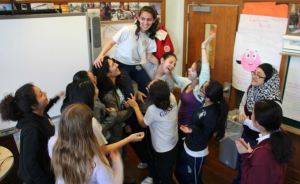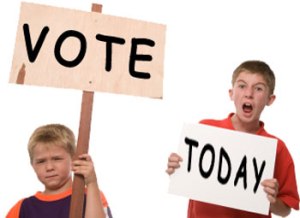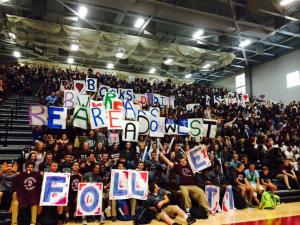by Susan Adelmann
Innovation to a kid growing up in Woodstock, IL in the early 70’s meant a trip to the new Baskin Robbins and the difficulty of selecting just one of those 31 flavors displayed side by side in the long ice cream cooler. For me, the young radical at age 10, it was always the bubble gum ice cream. There may be better techniques to eating ice cream with gum in it at the same time, but for me it always ended with the double treat and soggy prize of extracted gum pieces waiting to be enjoyed after that last bite of cone. And this was the essence of disruptive innovation ala 10 year old kid in 1974.
Why the trip down memory lane? And what does this have to do with the Follett Challenge?
Both are great examples of disruptive innovation and both are truly delightful. Choosing from those 31 buckets of ice cream was delightful and the bubble gum treat that kept on giving was, too.
There aren’t so many things in my adult life that can trigger the same kind of delight, but I really do feel the same way working my way through the incredible assortment of Follett Challenge videos that have been shared by our customers since we launched the Challenge.
Between this year and last year alone, there are 226 flavors of innovation and inspiration, all archived for your viewing delight at FollettChallenge.com. Use this link to explore and see if you don’t agree with me that they line up just like buckets of ice cream at the ice cream counter.
You might sample the innovation of Delaware Valley Elementary School in Milford, PA, where fifth grade students have been broadcasting a live television show every morning for the past 22 years. DVE-TV airs on public television in New York, New Jersey, Pennsylvania and on the internet. Over the years, more than 1,400 fifth graders have spent at least one school year as reporters for the program. They choose news, features, sports and weather. They use computers to research and write scripts in their own words, and then broadcast their stories live every day at 9:00 am. These fifth graders and the students they reach are preparing for the 21st century by blending their voice with the world around them and learning in a personal way about the events, leaders and issues that they will face as adults.
Or, you can find North Park Junior High School in Lockport, NY, where they changed their school’s culture and climate by rallying around Miranda Lambert’s “All Kinds of Kinds” song with an “All Kinds of Kinds” program that engaged students to identify themselves using 800 different signs and celebrate their uniqueness and individuality working together to create a video. Their video brought together their school and community and went viral attracting news stations—eventually reaching Miranda Lambert herself. It’s impossible to watch the video and not be inspired at how the effort and creativity that starts with just a small group of people can catch on and spark meaningful change.
Then there is P.S. 54 in Bronx, NY, where the school library media center has become the center of collaboration between classroom teachers, a science teacher and gym teacher to promote an interdisciplinary approach to information fluency, literacy, citizenship, and technology through a Community Garden Project. That’s right; the library media center implemented a vegetable garden using pallets which are otherwise regularly discarded as junk. While building gardens and caring for the plants, students create, solve problems, and learn about a variety of interdisciplinary subjects.
Or check out the Ardmore Hackers of Lakeview Middle School in St. Clair Shores, MI, where fifth graders are hacking their education in a maker pilot program that has sparked interest and had a tremendous impact on participating students. Not only has the program been a success, but new teaching strategies piloted in the program are carrying over into more traditional classroom curriculum. Test scores have soared in content areas covered by the program and it has sparked great interest, enthusiasm, and support from students and parents alike.
The best part here is you don’t have to just select one – by my count there are 226 flavors of innovation at the Follett Challenge ice cream counter. If you’re ever in need of inspiration this is the place to be. Click anywhere and prepare to be inspired as you think about submitting your own Follett Challenge entry… or any old day you need a reminder of how just a few motivated people really can change the world.
Ice cream analogies aside and reflecting in all seriousness on the small slice of K-12 education that we see through the lens of the Follett Challenge, we don’t ever forget the challenges educators face every day are daunting. From teaching to new standards amidst controversy, to stretched budgets; from kids who face food insecurity or wonder where they will sleep, to principals charged with keeping kids safe in school—we know you face complex and difficult issues each and every day. And yet somehow, with passion and conviction, we see you rise beyond these challenges and push forward amazing, thoughtful, inspiring, and innovative programs like those exemplified here. Against that backdrop, it makes these videos and the work behind them that much more of a special treasure—one to be shared and celebrated.
Thank you Follett Challengers – your innovation inspires me and delights me!

Susan Adelmann is a judge for the Follett Challenge and vice president, market intelligence for Follett School Solutions, a division of Follett Corporation. In her 7 years at Follett, Susan’s work has centered on digital and personalized learning platforms, data measurement and interoperability and other emerging technologies that support 21st century learning in K-12 schools. Prior to joining Follett, Susan held a variety of engineering and marketing leadership roles in the software industry. Notable achievements include leading the development and launch of what is today the Epicor Vision distribution system, along with guiding the direct marketing product launch efforts for numerous high profile software companies and technology media publishers. Susan punctuated her 30 year technology career with a passion for teaching and learning as a community college Computer Science instructor. As a digital learning evangelist, Susan is an industry speaker on education technology trends and opportunities and she currently serves on several working groups and the board of directors for the Software & Information Industry Association (SIIA), Education Division.


















